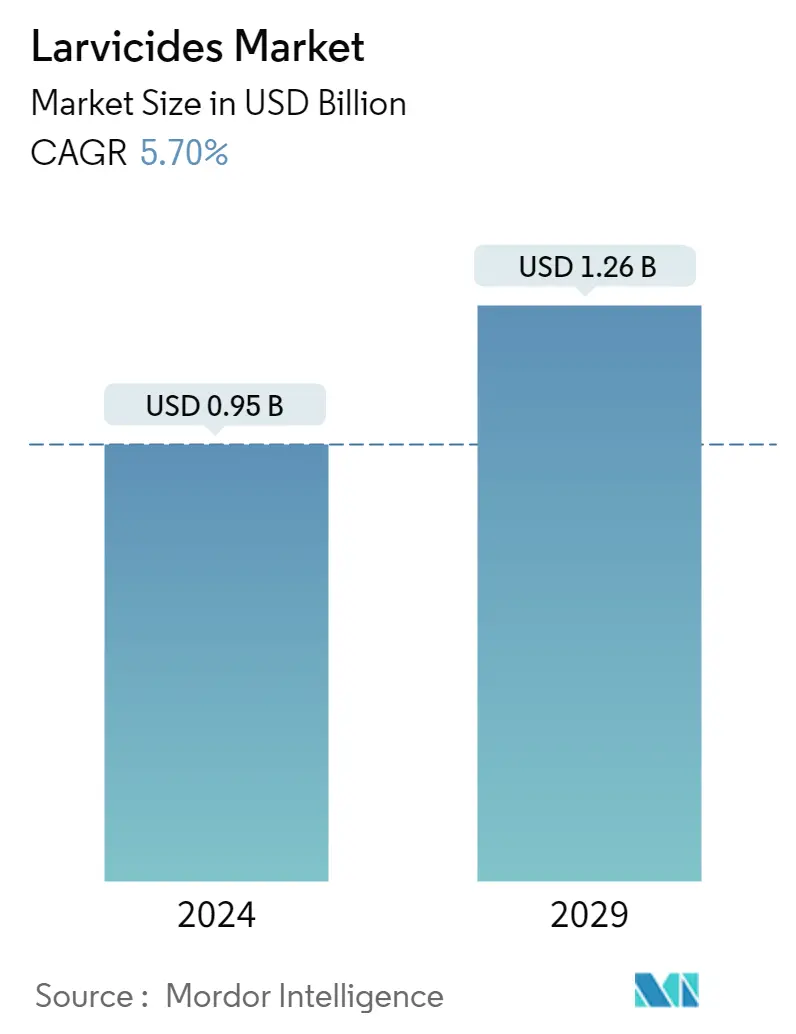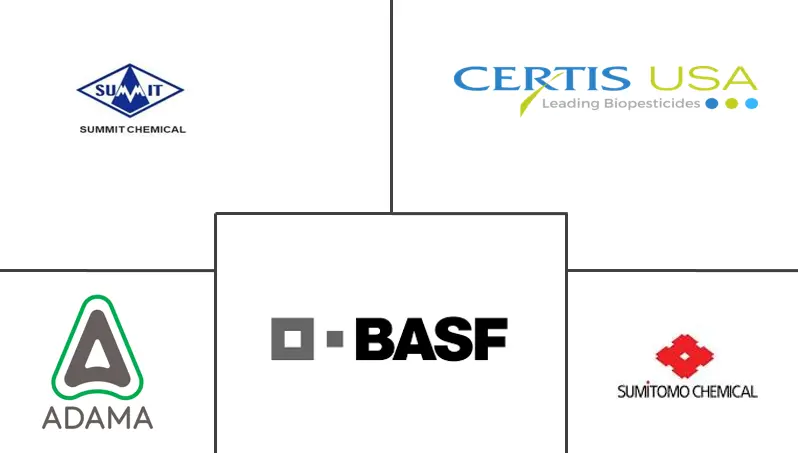Market Size of Larvicides Industry

| Study Period | 2019 - 2029 |
| Market Size (2024) | USD 0.95 Billion |
| Market Size (2029) | USD 1.26 Billion |
| CAGR (2024 - 2029) | 5.70 % |
| Fastest Growing Market | Asia Pacific |
| Largest Market | North America |
Major Players
*Disclaimer: Major Players sorted in no particular order |
Larvicides Market Analysis
The Larvicides Market size is estimated at USD 0.95 billion in 2024, and is expected to reach USD 1.26 billion by 2029, growing at a CAGR of 5.70% during the forecast period (2024-2029).
The sudden outbreak of COVID-19 led to the implementation of stringent lockdown regulations across several nations, resulting in disruptions in the import and export activities of larvicides. Local government departments and mosquito control districts lead large-scale mosquito control activities during an outbreak. One activity is to apply larvicides. Licensed mosquito control professionals apply Environmental Protection Agency (EPA)-registered larvicides using backpack sprayers, trucks, or airplanes, depending on the size of the area being affected.
According to the WHO, 40% of the population living in underdeveloped countries is at risk of serious diseases, such as malaria, which is one of the life-threatening diseases caused by parasites transmitted by female anopheles mosquitoes. For instance, in 2017, there were an estimated 219 million malaria cases in 87 countries, and the total funding for malaria control was estimated at USD 3.1 billion. State contributions from tropical countries contributed to USD 900 million, accounting for 28% of total funding. An increasing number of disease outbreaks, vector-based epidemics, and growing pest attacks are some of the major factors driving the larvicides market globally. Among the regions, Asia-Pacific holds the major share in the larvicides market due to climate change, which poses a threat to public health caused by urban pests.
Larvicides Industry Segmentation
The larvicides market is segmented by control method, product type, application, and geography. The report offers market size and forecast in terms of value (USD million) for all the above segments.
| Application | |
| Agriculture | |
| Non-agriculture |
| Control Method | |
| Bio Control Agent | |
| Chemical Agent | |
| Insect Growth Regulator |
| Product Type | |
| Synthetic Larvicides | |
| Natural Larvicides | |
| Biological Larvicides |
| Target Insect | |
| Mosquitoes | |
| Flies | |
| Other Target Insects |
| Geography | ||||||||
| ||||||||
| ||||||||
| ||||||||
| ||||||||
|
Larvicides Market Size Summary
The larvicides market is poised for significant growth, driven by the increasing prevalence of vector-borne diseases and the need for effective pest control solutions. The market is experiencing a surge in demand due to the rising incidence of diseases such as malaria, dengue, and chikungunya, which are transmitted by mosquitoes. This demand is further fueled by the growing urbanization and climate change, particularly in the Asia-Pacific region, where public health is threatened by urban pests. The market is characterized by a diverse range of products, including liquid, tablet, pellet, granular, and briquet formulations, which are applied to water bodies and breeding areas to control mosquito populations. The involvement of multinational companies and government spending in developing regions are also contributing to the market's expansion.
North America stands as the largest consumer of larvicides, supported by robust surveillance and vector control programs, with the United States and Canada leading the charge. The market is highly fragmented, with major players like Adama, BASF, and Sumitomo Chemical employing strategies such as joint ventures, product launches, and acquisitions to enhance their market presence. The regulatory landscape, particularly in the United States, plays a crucial role, with the Environmental Protection Agency overseeing the registration of various larval control agents. The market's growth trajectory is further supported by innovations such as ADAMA's Eagle Eye service, which leverages aerial data analysis to optimize pest control efforts. As the global focus on public health and ecological sustainability intensifies, the larvicides market is expected to witness continued expansion and diversification.
Larvicides Market Size - Table of Contents
-
1. MARKET DYNAMICS
-
1.1 Market Overview
-
1.2 Market Drivers
-
1.3 Market Restraints
-
1.4 Porter's Five Forces Analysis
-
1.4.1 Threat of New Entrants
-
1.4.2 Bargaining Power of Buyers/Consumers
-
1.4.3 Bargaining Power of Suppliers
-
1.4.4 Threat of Substitute Products
-
1.4.5 Intensity of Competitive Rivalry
-
-
-
2. MARKET SEGMENTATION
-
2.1 Application
-
2.1.1 Agriculture
-
2.1.2 Non-agriculture
-
-
2.2 Control Method
-
2.2.1 Bio Control Agent
-
2.2.2 Chemical Agent
-
2.2.3 Insect Growth Regulator
-
-
2.3 Product Type
-
2.3.1 Synthetic Larvicides
-
2.3.2 Natural Larvicides
-
2.3.3 Biological Larvicides
-
-
2.4 Target Insect
-
2.4.1 Mosquitoes
-
2.4.2 Flies
-
2.4.3 Other Target Insects
-
-
2.5 Geography
-
2.5.1 North America
-
2.5.1.1 United States
-
2.5.1.2 Canada
-
2.5.1.3 Mexico
-
2.5.1.4 Rest of North America
-
-
2.5.2 Europe
-
2.5.2.1 Germany
-
2.5.2.2 United Kingdom
-
2.5.2.3 France
-
2.5.2.4 Russia
-
2.5.2.5 Spain
-
2.5.2.6 Rest of Europe
-
-
2.5.3 Asia-Pacific
-
2.5.3.1 India
-
2.5.3.2 China
-
2.5.3.3 Japan
-
2.5.3.4 Rest of the Asia-Pacific
-
-
2.5.4 South America
-
2.5.4.1 Brazil
-
2.5.4.2 Argentina
-
2.5.4.3 Rest of South America
-
-
2.5.5 Africa
-
2.5.5.1 South Africa
-
2.5.5.2 Rest of Africa
-
-
-
Larvicides Market Size FAQs
How big is the Larvicides Market?
The Larvicides Market size is expected to reach USD 0.95 billion in 2024 and grow at a CAGR of 5.70% to reach USD 1.26 billion by 2029.
What is the current Larvicides Market size?
In 2024, the Larvicides Market size is expected to reach USD 0.95 billion.

